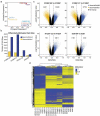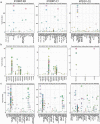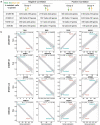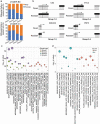Hypermethylation and global remodelling of DNA methylation is associated with acquired cisplatin resistance in testicular germ cell tumours
- PMID: 33126827
- PMCID: PMC8510620
- DOI: 10.1080/15592294.2020.1834926
Hypermethylation and global remodelling of DNA methylation is associated with acquired cisplatin resistance in testicular germ cell tumours
Abstract
Testicular germ cell tumours (TGCTs) respond well to cisplatin-based therapy. However, cisplatin resistance and poor outcomes do occur. It has been suggested that a shift towards DNA hypermethylation mediates cisplatin resistance in TGCT cells, although there is little direct evidence to support this claim. Here we utilized a series of isogenic cisplatin-resistant cell models and observed a strong association between cisplatin resistance in TGCT cells and a net increase in global CpG and non-CpG DNA methylation spanning regulatory, intergenic, genic and repeat elements. Hypermethylated loci were significantly enriched for repressive DNA segments, CTCF and RAD21 sites and lamina associated domains, suggesting that global nuclear reorganization of chromatin structure occurred in resistant cells. Hypomethylated CpG loci were significantly enriched for EZH2 and SUZ12 binding and H3K27me3 sites. Integrative transcriptome and methylome analyses showed a strong negative correlation between gene promoter and CpG island methylation and gene expression in resistant cells and a weaker positive correlation between gene body methylation and gene expression. A bidirectional shift between gene promoter and gene body DNA methylation occurred within multiple genes that was associated with upregulation of polycomb targets and downregulation of tumour suppressor genes. These data support the hypothesis that global remodelling of DNA methylation is a key factor in mediating cisplatin hypersensitivity and chemoresistance of TGCTs and furthers the rationale for hypomethylation therapy for refractory TGCT patients.
Keywords: Cisplatin; DNA methylation; chemoresistance; testicular germ cell tumour.
Conflict of interest statement
The authors declare no conflict of interest.
Figures






Similar articles
-
Differential methylation EPIC analysis discloses cisplatin-resistance related hypermethylation and tumor-specific heterogeneity within matched primary and metastatic testicular germ cell tumor patient tissue samples.Clin Epigenetics. 2021 Apr 6;13(1):70. doi: 10.1186/s13148-021-01048-y. Clin Epigenetics. 2021. PMID: 33823933 Free PMC article.
-
Reciprocal epigenetic remodeling controls testicular cancer hypersensitivity to hypomethylating agents and chemotherapy.Mol Oncol. 2022 Feb;16(3):683-698. doi: 10.1002/1878-0261.13096. Epub 2021 Sep 15. Mol Oncol. 2022. PMID: 34482638 Free PMC article.
-
Refractory testicular germ cell tumors are highly sensitive to the second generation DNA methylation inhibitor guadecitabine.Oncotarget. 2017 Jan 10;8(2):2949-2959. doi: 10.18632/oncotarget.13811. Oncotarget. 2017. PMID: 27936464 Free PMC article.
-
The epigenome of testicular germ cell tumors.APMIS. 2007 Oct;115(10):1147-60. doi: 10.1111/j.1600-0463.2007.apm_660.xml.x. APMIS. 2007. PMID: 18042148 Review.
-
Molecular Mechanisms of Cisplatin Chemoresistance and Its Circumventing in Testicular Germ Cell Tumors.Curr Oncol Rep. 2018 Sep 26;20(11):88. doi: 10.1007/s11912-018-0730-x. Curr Oncol Rep. 2018. PMID: 30259297 Review.
Cited by
-
Global analysis of DNA methylation changes during experimented lingual carcinogenesis.Hua Xi Kou Qiang Yi Xue Za Zhi. 2024 Jun 1;42(3):319-328. doi: 10.7518/hxkq.2024.2023416. Hua Xi Kou Qiang Yi Xue Za Zhi. 2024. PMID: 39049651 Free PMC article. Chinese, English.
-
Recent Advancements in Research on DNA Methylation and Testicular Germ Cell Tumors: Unveiling the Intricate Relationship.Biomedicines. 2024 May 8;12(5):1041. doi: 10.3390/biomedicines12051041. Biomedicines. 2024. PMID: 38791003 Free PMC article. Review.
-
Between a Rock and a Hard Place: An Epigenetic-Centric View of Testicular Germ Cell Tumors.Cancers (Basel). 2021 Mar 25;13(7):1506. doi: 10.3390/cancers13071506. Cancers (Basel). 2021. PMID: 33805941 Free PMC article. Review.
-
Biomarkers for Salvage Therapy in Testicular Germ Cell Tumors.Int J Mol Sci. 2023 Nov 28;24(23):16872. doi: 10.3390/ijms242316872. Int J Mol Sci. 2023. PMID: 38069192 Free PMC article. Review.
-
Children's Oncology Group's 2023 blueprint for research: Germ cell tumors.Pediatr Blood Cancer. 2023 Sep;70 Suppl 6(Suppl 6):e30562. doi: 10.1002/pbc.30562. Epub 2023 Jul 14. Pediatr Blood Cancer. 2023. PMID: 37449938 Free PMC article.
References
-
- Bray F, Ferlay J, Soerjomataram I, et al. Global cancer statistics 2018: GLOBOCAN estimates of incidence and mortality worldwide for 36 cancers in 185 countries. CA Cancer J Clin. 2018;68:394–424. - PubMed
-
- Adra N, Einhorn LH.. Testicular cancer update. Clin Adv Hematol Oncol. 2017;15:386–396. - PubMed
-
- Lavoie JM, Kollmannsberger CK.. current management of disseminated germ cell tumors. Urol Clin North Am. 2019;46:377–388. - PubMed
-
- Feldman DR, Patil S, Trinos MJ, et al. Progression-free and overall survival in patients with relapsed/refractory germ cell tumors treated with single-agent chemotherapy: endpoints for clinical trial design. Cancer. 2012;118:981–986. - PubMed
-
- Allen JC, Kirschner A, Scarpato KR, et al. Current management of refractory germ cell tumors and future directions. Curr Oncol Rep. 2017;19:8. - PubMed
MeSH terms
Substances
Supplementary concepts
Grants and funding
LinkOut - more resources
Full Text Sources
Other Literature Sources
Medical
Molecular Biology Databases
